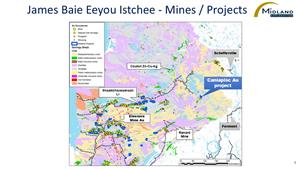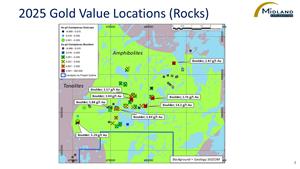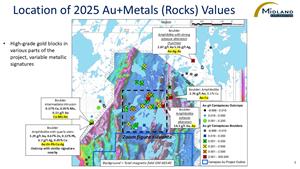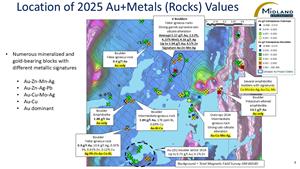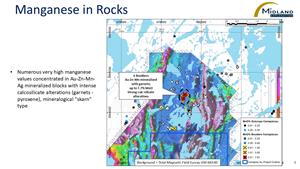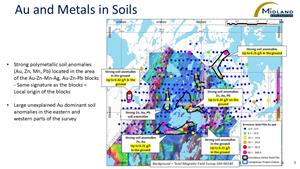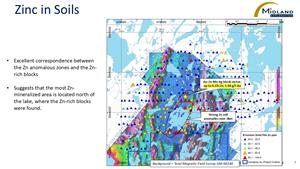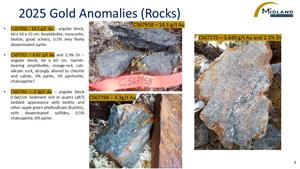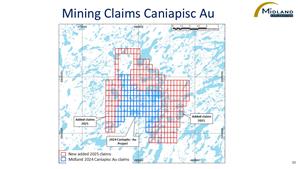Midland Discovers an Important Gold-Zinc-Silver Mineralized System on Its Caniapisc Au Project, James Bay
MONTREAL, Sept. 09, 2025 (GLOBE NEWSWIRE) -- Midland Exploration Inc. (“Midland”) (TSX-V: MD) is pleased to announce the recent discovery of a major gold-zinc-silver mineralized system on its Caniapisc Au project. The Caniapisc Au project is wholly owned by Midland and consists of 296 claims (EER) covering an area of 146 square kilometres.
Highlights:
- Several important clusters of Au-Zn-Mn-Ag and Au-Zn-Ag-(Pb)-bearing boulders coinciding with extensive Au-Zn anomalies in soils;
- Eight (8) rock samples (boulders) with gold values above 1.00 g/t Au (max of 14.3 g/t Au); 5 rock samples (boulders) with zinc values above 1% Zn (max of 4.5% Zn);
- Twenty-seven (27) soil samples with values above 10 ppb Au, including 6 soil samples with values greater than 100 ppb Au (max of 423 ppb Au);
- Thirty-four (34) rock samples (boulders) with gold values above 0.10 g/t Au;
- Diverse metal assemblages - Au-Zn-(Pb), Au-Zn-Mn, Cu-Mo-Au-Ag, Au-Cu, Au only – in distinct lithologies, suggesting several distinct gold sources and a fertile environment for Au;
- Acquisition by map designation of 201 new claims (EER) along the periphery of the Caniapisc Au gold property;
-
The 2024 till program confirmed historical gold anomalies with up to 100 gold grains per 10 kg of till (November 14, 2024 Press release and 2014 report; GM 67959 Ministry of Natural Resources and Forest)
A ten (10)-day geological reconnaissance campaign was conducted last June on the Caniapisc Au project. The main objectives of this campaign were to explain several Au-Zn-Pb-Mo anomalies discovered in 2024 (November 14, 2024 Press release) to conduct our first geological assessment of its gold potential, and to carry out a prospecting campaign and a soil survey covering most of the project area. A total of 159 rock samples and 318 soil samples (B horizon) were collected.
2025 Rock Sampling Results
Within a 2-kilometre radius up-ice from historical gold anomalies in tills (2014 report; GM 67959 Ministry of Natural Resources and Forest), prospecting efforts successfully identified boulder fields (with subangular to angular boulders) and outcrops showing anomalous values for Au and various other metals (Zn, Mn, Pb, Cu, Mo, Ag). Very few outcrops are present within the project area; boulder prospecting thus becomes a valuable tool in this type of environment. Out of a total of 159 isolated samples (grab samples) collected during this campaign, 8 yielded gold values above 1.00 g/t Au, including a maximum value of 14.3 g/t Au, and 34 samples yielded gold values between 0.10 and 1.00 g/t Au (Table 1). Five (5) grab samples (rocks) also yielded zinc (Zn) values above 1% (max 4.5% Zn). The same five (5) samples also exhibited high manganese (MnO) values reaching up to 7.67% MnO. All of the 2025 samples with anomalous gold and zinc values were collected in boulders (figure 3 to 6).
Gold Results from the 2025 Soil Survey
Gold results for the 318 soil samples (B horizon) collected on the property include 6 values greater than 100 ppb Au (max = 423 ppb Au), 1 value between 50 and 100 ppb, and 20 values between 10 and 50 ppb. An extensive anomaly (around a lake in the south part of the project) is characterized by an Au-Zn-Mn signature. Four (4) other strong anomalies in soils (Au-only) are also present within the survey area (Figure 7).
Metal Assemblages in Rocks
Sampling conducted in 2024-2025 in this area led to the identification of several distinct metal assemblages in boulders and outcrops (Table 2). Many boulders exhibit gold-zinc-silver-lead (Au-Zn-Ag-Pb), gold-zinc-manganese-silver (Au-Zn-Mn-Ag), or copper-molybdenum-gold-silver (Cu-Mo-Au-Ag; boulders and outcrops) assemblages. Au-Zn-Ag-Pb and Au-Zn-Mn-Ag boulders are, for the most part, located near a lake in the south part of the project area (Figure 4), and their origin is deemed local, within the immediate vicinity, based on the distribution of boulders and coinciding soil anomalies. The five (5) samples grading above 1% Zn are located in this area (max 4.5% Zn). Au-Zn-Mn mineralization (which yielded the highest Zn grades) is associated with very strong calc-silicate alteration (+Ca-Fe-Mg-Si, amphibole-garnet-calcite in descriptions) accompanied by nearly complete Na-K leaching.
Numerous other gold-bearing boulders sampled in various parts of the project exhibit metal assemblages different from these Au-Zn-Ag-Pb, Au-Zn-Mn-Ag and Cu-Mo-Au-Ag assemblages (Table 2), namely including Au-Cu and Au-dominant assemblages, which likely indicate distinct sources of gold. In particular, an amphibolite boulder with potassic alteration located approximately 800 metres east of the Au-Zn-Mn boulders graded 14.3 g/t Au. Another amphibolite boulder with strong potassic alteration (fuchsite), located more than 3 kilometres northeast of the Au-Zn-Mn boulders, graded 2.87 g/t Au with anomalous As values (the only As anomaly in the area). The source of these boulders has not yet been located and is considered distinct from Au-Zn-Ag (Mn-Pb) and Cu-Mo-Au-Ag boulders. A highly angular boulder of amphibolite with quartz veining, located in the west part of the project, graded 3.29 g/t Au, 0.67% Zn, 0.12% Pb, 0.05% Cu and 6.7 g/t Ag. This boulder is located near an amphibolite outcrop that also exhibits anomalous Au, Zn and Pb values and as such, is considered of local origin and a high-priority target for follow-up.
The very strongly similar alteration assemblages associated with Au-Zn-Mn and Cu-Mo signatures suggest they may represent the same mineralization system. The Cu-Mo signature is most certainly magmatic-hydrothermal (associated with felsic intrusions), indicating the Au-Zn-Mn mineralization is likely related to this system as a more distal facies. The remarkable intensity of the calc-silicate alteration suggests skarn-type mineralization, as well as the possibility that extreme calcium enrichment may be explained by calcium-rich protoliths. Zn-Mn mineralization is fairly typical in zinc-rich skarn settings.
Table 1: Best Metal Values Obtained in Boulder Samples in 2025
| Unit Symbol | g/t | g/t | % | ppm | ppm | g/tonne | % |
| Analysis Method | FA-ICP | FA-AA | ICP-OES | TD-MS | TD-MS | FA-GRA | FUS-Na2O2 |
| Analyte Symbol | Au | Au | MnO | Ag | Zn | Au | Zn |
| C567958 | 13.10 | > 5.00 | 0.21 | 0.55 | 136 | 14.3 | |
| C567775 | 3.94 | 4.67 | 6.00 | 8.98 | > 10000 | 2.29 | |
| C567856 | 3.29 | 3.49 | 0.29 | 6.72 | 6750 | ||
| C567794 | 2.87 | 3.37 | 0.01 | 5.36 | 102 | ||
| C567805 | 2.76 | 2.60 | 0.22 | 1.22 | 109 | ||
| C567765 | 1.88 | 2.21 | 0.15 | 0.2 | 117 | ||
| C567762 | 1.84 | 1.53 | 0.10 | 0.35 | 52.8 | ||
| C567917 | 1.17 | 1.36 | 1.49 | 4.94 | > 10000 | 1.04 | |
| C567965 | 0.89 | 1.04 | 0.11 | 10.6 | 4080 | ||
| C567784 | 0.76 | 0.91 | 3.32 | 0.83 | 9810 | ||
| C567785 | 0.59 | 0.76 | 5.16 | 7.64 | > 10000 | 1.95 | |
| C567781 | 0.43 | 0.46 | 7.67 | 1.34 | > 10000 | 1.98 |
Table 2: Summary Metal Assemblages Observed in Metal-Enriched Rock Samples Collected in 2024-2025 (n=15 in 2024; n=44 in 2025)
|
Type of assemblage |
Number of boulders (outcrops) |
Average grades (grab samples) | Max values (grab samples) | ||||||||||
| Au (g/t) |
Zn (%) |
MnO (%) |
Ag (g/t) |
Pb (%) |
Cu (%) |
Mo (%) |
Au (g/t) |
Zn (%) |
MnO (%) |
||||
| Au-Zn-Mn-Ag | 6 (0) | 1.17 | 2.12 | 4.23 | 4.16 | NS | NS | NS | 3.94 | 4.50 | 7.67 | ||
| Au-Zn-Ag±Pb | 13 (0) | 0.50 | 0.23 | 0.43 | 3.48 | 0.05 | NS | NS | 3.29 | 0.67 | 1.14 | ||
| Au-Cu-Mo-Ag | 3 (2) | 0.20 | NS | 0.22 | 3.27 | NS | 0.10 | 0.03 | 0.38 | 0.03 | 0.47 | ||
| Au-Cu | 5 (0) | 1.00 | NS | 0.21 | 1.52 | NS | 0.11 | NS | 2.76 | NS | 0.21 | ||
| Au only/dominant > 1 g/t | 3 (0) | 6.35 | 2.03 | NS | 2.03 | NS | NS | NS | 14.2 | NS | NS | ||
| Au only/dominant 0.1 – 1 g/t | 27 (0) | 0.23 | NS | NS | 1.74 | NS | NS | NS | 0.60 | 0.05 | 0.9 | ||
NS = not significant
New Exploration Program
Midland is pleased to announce the acquisition, by map designation, of 201 new claims along the perimeter of its Caniapisc-Au gold property, wholly owned by Midland.
A 10-day exploration program will be conducted in the coming weeks on the Caniapisc Au project. This program will include geological mapping combined with prospecting, as well as an extensive soil sampling program to cover areas that were not covered during the previous phase as well as the new EER recently acquired on the project. A total of 200 soil samples will be collected at a 200-metre spacing along grid lines spaced every 400 metres. A tighter spacing is planned in the vicinity of new gold anomalies in soils.
About the Caniapisc Au Project
The Caniapisc Au project lies south of the Caniapiscau Reservoir and is geologically located within the Ashuanipi Subprovince, a lesser known and explored portion of the Archean Superior Province. The project is more specifically located in the Raynouard Complex, characterized by a 50 kilometre-long volcanosedimentary belt comprising bimodal volcanic sequences, metasedimentary rocks and iron formations. Historical exploration work, to the south of the Caniapisc Au project, highlights the potential of the Raynouard Complex with the presence of volcanogenic Cu-Zn-Ag-Au and porphyry Cu-Au-Ag-Mo mineralization. The Caniapisc Au project is strategically located north of these showings, where a historical 2014 till sampling survey identified gold anomalies. Three (3) till samples, located within the perimeter of the project, returned up to 41 pristine, 66 modified, and 9 remodeled gold grains, which to our current knowledge have not been followed up extensively.
Quality Control
Rock samples from the project were analyzed at Actlabs laboratories in Ancaster, Ontario, by ICP-MS with 4-acid digestion for metals, and by standard fire assay on 30-gram fractions with atomic absorption finish for gold and by ICP-OES fusion for major elements (including MnO). Soil samples are processed and analyzed at Actlabs laboratories in Ancaster, Ontario, by neutron activation (namely for Au) and ICP-OES with 4-acid extraction (namely for Zn and Mn), after sieving to -177 microns. Exploration programs are designed, and results are interpreted by Qualified Persons employing a Quality Assurance/Quality Control program consistent with industry best practices, including the alternate use of standards and blanks for every 20 samples.
Cautionary statements
Grab samples are selective by nature and may not be representative of mineralized zones.
Mineralization occurring at deposits and showings mentioned in this press release is not necessarily indicative of mineralization that may be found on projects held by Midland and mentioned in this press release.
About Midland
Midland targets the excellent mineral potential of Quebec to make the discovery of new world-class deposits of gold and critical metals. Midland is proud to count on reputable partners such as Rio Tinto Exploration Canada Inc., BHP Canada Inc., Centerra Gold Inc., Agnico Eagle Mines Limited, Wallbridge Mining Company Ltd, Probe Gold Inc., Electric Elements Mining Corp., SOQUEM Inc., Nunavik Mineral Exploration Fund, and Abcourt Mines Inc. Midland prefers to work in partnership and intends to quickly conclude additional agreements in regard to newly acquired properties. Management is currently reviewing other opportunities and projects to build up Midland’s portfolio and generate shareholder value.
Qualified Person and Exploration Director Richard D. St-Cyr, P.Geo., prepared this press release and verified the Caniapisc Au project data as Midland’s qualified person (QP) within the meaning of National Instrument 43-101.
For further information, please consult Midland’s website or contact:
Gino Roger, President and Chief Executive Officer
Tel.: 450 420-5977
Fax: 450 420-5978
Email: info@midlandexploration.com
Website: https://www.midlandexploration.com/
Neither TSX Venture Exchange nor its Regulation Services Provider (as that term is defined in the policies of the TSX Venture Exchange) accepts responsibility for the adequacy or accuracy of this release.
This press release may contain forward-looking statements that are subject to known and unknown risks and uncertainties that could cause actual results to vary materially from targeted results. Such risks and uncertainties include those described in Midland’s periodic reports including the annual report or in the filings made by Midland from time to time with securities regulatory authorities.
Photos accompanying this announcement are available at:
https://www.globenewswire.com/NewsRoom/AttachmentNg/30eb102f-858c-46e5-a24c-e31f2f65b00f
https://www.globenewswire.com/NewsRoom/AttachmentNg/ada28a9c-6e04-4f1a-88d9-e8b0f29b87c0
https://www.globenewswire.com/NewsRoom/AttachmentNg/33da35e5-dfcb-4ba7-9098-6a4d92d7ba18
https://www.globenewswire.com/NewsRoom/AttachmentNg/51737194-702b-4258-ab81-3ced84b67ca2
https://www.globenewswire.com/NewsRoom/AttachmentNg/59ff3b8b-8c5d-4645-8e26-ef10e348ed9f
https://www.globenewswire.com/NewsRoom/AttachmentNg/bc009e3f-e310-4e57-8068-4ebc9bd76b9a
https://www.globenewswire.com/NewsRoom/AttachmentNg/e153af14-4aa0-409c-8a0a-67ae85fa7196
https://www.globenewswire.com/NewsRoom/AttachmentNg/a02c2c1b-93e2-43df-aa5a-80a5dd90abd3
https://www.globenewswire.com/NewsRoom/AttachmentNg/0fc4f31b-4bba-4a04-8472-3adf3b875161
https://www.globenewswire.com/NewsRoom/AttachmentNg/f3ae2667-6ea4-4aff-9426-e8263706a3a3

Figure 1
James Bay Eeyou Istchee-Mines-Projects
Figure 2
2025 Gold Values Location (Rocks)
Figure 3
Location of 2025 Au+Metals (Rocks) Values
Figure 4
Location of 2025 Au+Metals (Rocks) Values
Figure 5
Manganese in Rocks
Figure 6
Au and Metals in Soils
Figure 7
Zinc in Soils
Figure 8
2025 Gold Anomalies (Rocks)
Figure 9
2025 Gold Anomalies (Rocks)
Figure 10
Mining Claims Caniapisc Au
Legal Disclaimer:
EIN Presswire provides this news content "as is" without warranty of any kind. We do not accept any responsibility or liability for the accuracy, content, images, videos, licenses, completeness, legality, or reliability of the information contained in this article. If you have any complaints or copyright issues related to this article, kindly contact the author above.

